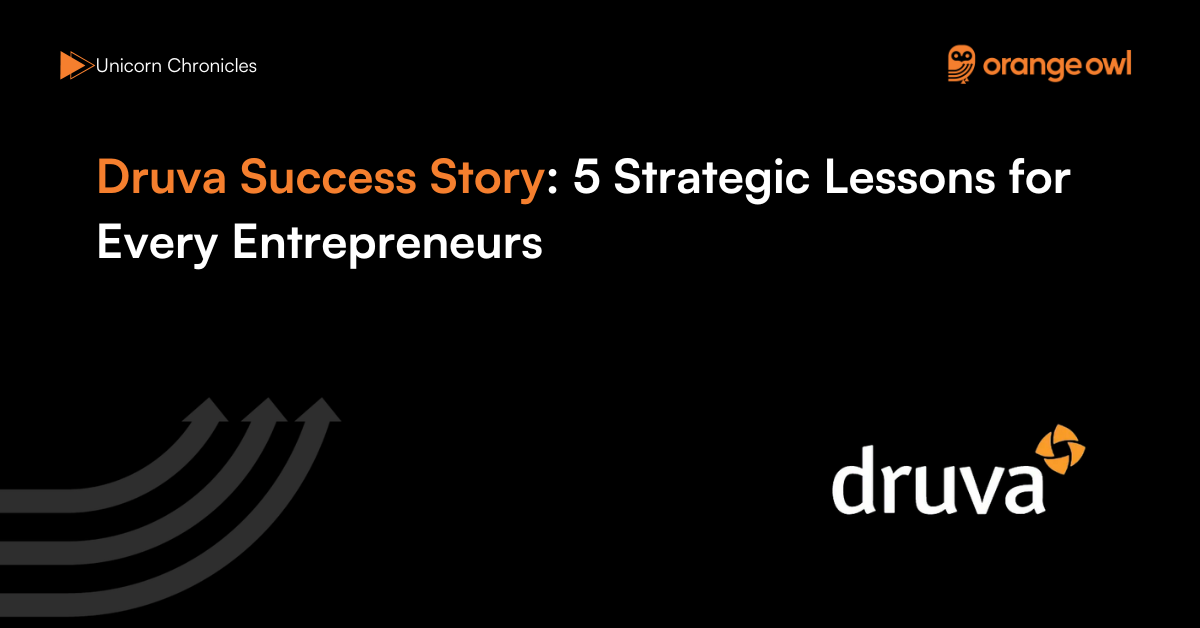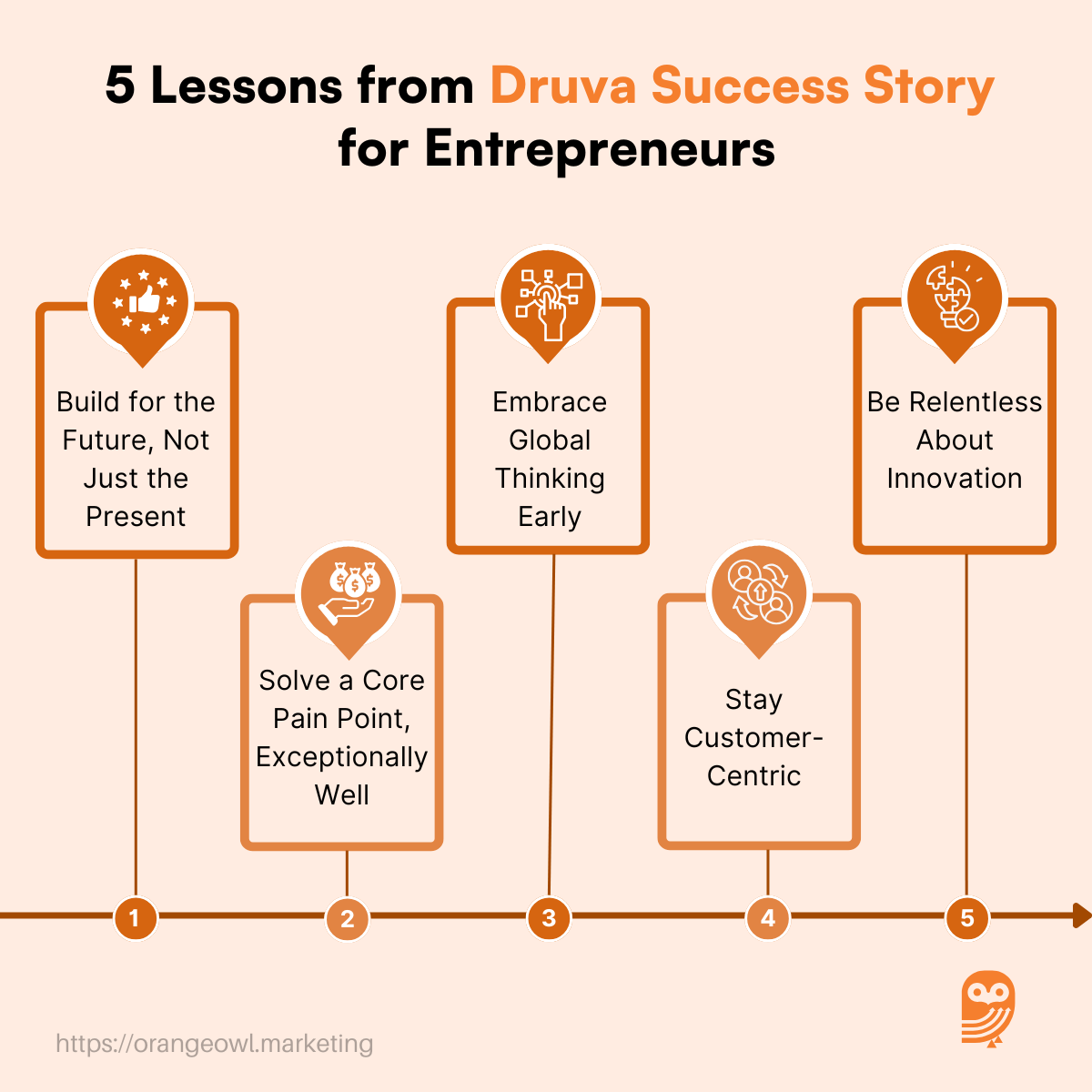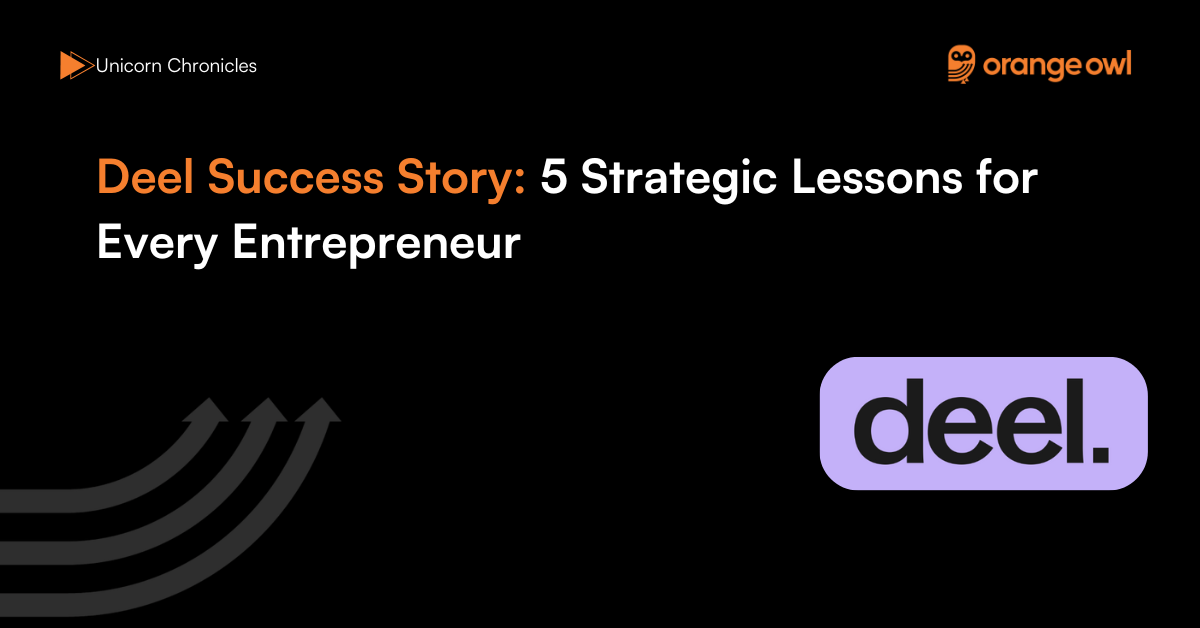Druva Success Story: 5 Strategic Lessons for Every Entrepreneurs
Vivek Goel
April 29, 2025

Table of Contents
Introduction
In the dynamic landscape of cloud computing, Druva Software has distinguished itself as a leader in data protection and resilience. Established in 2008 by Jaspreet Singh, Milind Borate, and Ramani Kothandaraman in Pune, India, Druva embarked on a mission to simplify and revolutionize data management through the cloud. Over the years, the company has evolved from a modest startup into a Silicon Valley-based unicorn, serving over 6,000 customers across more than 20 countries and managing upwards of 275 petabytes of data globally.
Druva’s cloud-native architecture sets it apart in a market traditionally dominated by hardware-centric legacy systems. As enterprises increasingly transition to cloud infrastructures, Druva’s model—offering backup, disaster recovery, and compliance as a service—has proven to be transformative.
“The future of data protection is not in boxes. It’s in the cloud, and it’s about intelligence and automation.” — Jaspreet Singh, Co-founder & CEO, Druva
Druva’s journey exemplifies the power of vision, resilience, and strategic execution, offering valuable insights for entrepreneurs aiming to build impactful technology solutions in the global arena.
Origin Story
The idea for Druva was sparked not in a boardroom, but in the trenches of enterprise IT. Founders Jaspreet Singh and Milind Borate, both seasoned engineers with deep experience in storage and infrastructure, saw firsthand how traditional data backup systems were failing modern businesses. These systems were complex, expensive, hardware-heavy, and often inefficient—making data protection an operational bottleneck rather than a strategic asset.
Their early experience in India revealed a stark gap: there was a pressing need for a cloud-native, software-defined solution that eliminated the need for on-premise appliances while still ensuring security, compliance, and resilience. This insight became the cornerstone of Druva’s mission—to radically simplify data protection for a cloud-first world.
What began in 2008 as a modest endpoint backup solution quickly evolved. As customers started migrating to cloud-based architectures, Druva expanded its offerings to include backup, archival, governance, eDiscovery, and disaster recovery for endpoints, SaaS applications (like Microsoft 365 and Google Workspace), and hybrid workloads across AWS and other environments. This expansion marked Druva’s transformation from a niche player to a comprehensive Data Resilience Cloud platform.
In 2012, recognizing the importance of proximity to the global tech and enterprise ecosystem, Druva strategically relocated its headquarters to Silicon Valley. This move not only helped attract top-tier talent and investment but also enabled deeper engagement with global enterprises, accelerating the company’s product development and market reach.
“We realized early on that the future was in delivering data protection as a service—not as boxes in a data center, but as scalable, intelligent cloud platforms.”— Jaspreet Singh, Co-founder & CEO, Druva
Today, that vision has become reality. Druva is one of the few companies to offer 100% SaaS-based data protection, with no hardware, no software, and no complexity—just seamless, scalable, and secure data resilience.
Business Landscape and Early Challenges
When Druva entered the enterprise data protection market in 2008, it was stepping into a battlefield dominated by well-entrenched players like Veritas, Commvault, EMC, and IBM. These legacy vendors had massive resources, deep customer relationships, and were built on decades-old infrastructures that revolved around physical appliances and complex deployments. The idea of moving sensitive enterprise data to the cloud—especially for backup and recovery—was still seen as radical, even risky.
On top of that, Druva’s origins in India posed additional challenges. In the early 2000s, the global enterprise SaaS landscape had few success stories from India. Many investors were hesitant to back an Indian-born product company targeting a global market, especially in an industry as critical and conservative as data protection. There were doubts about scalability, support, and credibility. But Druva chose to challenge the status quo, not conform to it.
Rather than mimic competitors, Druva reimagined data protection from the ground up, introducing a subscription-based SaaS model that didn’t require any on-premise hardware or software installations. This approach made their solution not just cost-effective but also frictionless to deploy and infinitely scalable, appealing especially to forward-thinking IT leaders looking to modernize.
To gain trust, Druva focused on deep technical excellence—building a platform that could seamlessly integrate with cloud infrastructure like AWS, offer airtight security and compliance, and provide centralized visibility across data sources. This dedication to product strength, combined with strong customer support, began to slowly chip away at enterprise skepticism.
“We believed data protection should be simple, scalable, and delivered like any other cloud service—without hardware, without friction.”— Jaspreet Singh, Co-founder & CEO, Druva
By betting early on cloud-native architecture and focusing on customer experience over infrastructure, Druva turned industry doubt into validation—emerging as a true disruptor in a space once thought impervious to change.
Growth Strategies
Druva’s meteoric rise to success can be attributed to several key strategic moves that allowed it to differentiate itself in the crowded cloud computing market.
One of the most important turning points for Druva was its pivot to a cloud-first architecture. In a landscape dominated by legacy, hardware-based solutions, Druva was one of the first companies in its space to fully embrace a 100% SaaS model built on Amazon Web Services (AWS). This early adoption of cloud technology gave Druva a significant competitive edge by allowing it to scale effortlessly, deploy faster, and drastically reduce the need for on-premise infrastructure. The ability to operate entirely in the cloud helped Druva to serve customers globally while maintaining operational efficiency and security.
Druva’s commitment to being a cloud-native solution enabled them to meet the evolving demands of modern enterprises, which were increasingly shifting workloads and data management to the cloud. The move not only allowed the company to position itself as a thought leader in the space but also laid the foundation for rapid scaling.
In addition to technological innovation, Druva focused heavily on addressing the unique needs of specific industry verticals. By crafting tailored solutions for sectors like healthcare, education, and finance, Druva provided high-value, specialized use cases that catered to industry-specific challenges, such as compliance, data privacy, and disaster recovery. This deep vertical focus helped Druva build strong relationships and trust with key stakeholders across multiple industries.
Strategic acquisitions also played a major role in Druva’s growth. In 2019, the company acquired CloudLanes, a leader in data migration for cloud environments, enhancing its hybrid cloud data protection offerings. In 2021, Druva acquired sfApex, a leading provider of cloud-native backup and disaster recovery solutions for Salesforce data, strengthening its position in the cloud CRM space. These acquisitions expanded Druva’s product capabilities and broadened its service offerings, making it an even more compelling solution for enterprises with complex IT environments.
The company’s Series H funding round in 2021, which raised $147 million from investors including CDPQ and Neuberger Berman, was another key milestone. This funding round pushed Druva’s valuation to over $2 billion and enabled further product development and global expansion, cementing its position as one of the most promising players in the data protection and resilience space.
“The cloud isn’t just another storage destination. It’s a fundamental rethinking of how enterprises should manage and protect data.” — Jaspreet Singh, Co-founder & CEO, Druva
Marketing Strategies
Druva’s marketing strategy has been equally innovative, built around a thought leadership and education-first approach that has not only helped the company gain industry credibility but also allowed it to generate high-quality leads and engage customers in a meaningful way.
At the core of Druva’s marketing playbook is its focus on content marketing. The company consistently produces valuable, insightful content that positions it as a trusted authority in cloud data protection. Whitepapers, product deep-dives, case studies, and benchmarking reports help Druva educate the market on the advantages of cloud-native data protection solutions and demonstrate how their technology addresses real-world challenges faced by enterprises. This content-first approach has been instrumental in attracting leads and nurturing them through the sales funnel.
Druva’s content focuses on solving tangible, pressing problems for its customers, such as ransomware protection, data compliance, and remote workforce management. By framing its product offering in terms of practical solutions to current enterprise challenges, Druva ensures that its message resonates with decision-makers who are looking for secure and scalable solutions.
Key elements of Druva’s marketing strategy include:
- Persona-based campaigns that are carefully tailored to target specific roles within an organization, such as IT Operations, CISOs, and compliance teams. These campaigns focus on addressing the unique pain points of each persona and offer targeted solutions.
- Webinars and demos that bring real-world use cases to life, showcasing how Druva’s platform helps organizations protect data and ensure business continuity.
- Active participation in leading industry events, such as AWS re:Invent, Gartner IT Symposium, and the RSA Conference, which not only helps raise Druva’s profile but also keeps it at the forefront of industry conversations.
- SEO-optimized landing pages and comparison tools, which help convert mid-funnel buyers by offering them side-by-side comparisons with competitors and showcasing the unique advantages of Druva’s solutions.
“Our goal isn’t just to sell software—it’s to make businesses resilient through intelligent data.” — Jaspreet Singh, Co-founder & CEO, Druva
Through these strategies, Druva has successfully built a loyal customer base, developed lasting industry relationships, and continues to grow its market share in the competitive cloud data protection space.
5 Lessons Every Entrepreneur Should Learn from Druva
1. Build for the Future, Not Just the Present
Druva’s decision to build a cloud-native architecture was not just a tactical move; it was a strategic vision that set them apart in an industry dominated by hardware-heavy solutions. By adopting cloud-first technology early on, Druva positioned itself to benefit from the inevitable digital transformation that would sweep across businesses. This forward-thinking mindset allowed the company to scale rapidly and efficiently while offering a highly flexible and scalable solution.
For entrepreneurs, this teaches the importance of anticipating the future and making decisions that will not only address today’s problems but also provide a platform for long-term growth and success. Druva’s ability to foresee the growth of cloud computing and act early on that insight was a game-changer, allowing it to become a leader in its space.
“We built Druva with the vision that data protection would eventually live in the cloud. We wanted to be ready when the market was ready.”— Jaspreet Singh, Co-founder & CEO, Druva
2. Solve a Core Pain Point, Exceptionally Well
Rather than trying to be everything to everyone, Druva focused on solving one core problem: data protection. By offering cloud-native backup and disaster recovery solutions, Druva became a specialist in its field, providing exceptional value to businesses seeking to protect their critical data. This deep focus on a single issue allowed Druva to build its reputation as a trusted expert and led to high customer satisfaction.
For entrepreneurs, this lesson emphasizes the importance of focusing on a core problem and providing a best-in-class solution. By solving a specific pain point exceptionally well, Druva was able to build a loyal customer base and scale its business over time without spreading itself too thin.
3. Embrace Global Thinking Early
Though Druva was founded in India, its founders were always driven by a global vision. From the beginning, they knew that the enterprise market was global, and they made the conscious decision to build a company that could scale internationally. In 2012, they took a pivotal step by moving the company to Silicon Valley, aligning with key partners like AWS to build relationships and strengthen their global presence.
This global approach helped Druva gain credibility and access to the enterprise market in North America, a crucial move in the company’s trajectory. Entrepreneurs should learn the value of thinking beyond local boundaries and positioning their business to cater to international markets from the start.
“Our move to Silicon Valley wasn’t just about proximity to customers; it was about immersing ourselves in the innovation ecosystem that would help us scale globally.” — Jaspreet Singh, Co-founder & CEO, Druva

4. Stay Customer-Centric
Druva’s focus on customer feedback has been one of the key drivers of its success. The company regularly interacted with customers to understand their pain points and needs, which helped shape the product’s evolution. By staying customer-centric, Druva was able to build products that were not only highly relevant but also had a sticky effect, leading to high retention and organic growth.
Entrepreneurs can take away the importance of listening to customers and using their feedback to improve the product. By consistently iterating based on real-world usage and problems, Druva turned its product into an indispensable tool for its users, driving both customer satisfaction and brand loyalty.
5. Be Relentless About Innovation
One of the most striking aspects of Druva’s journey is its commitment to continuous innovation. From its early days offering endpoint backup to transitioning into a full data resilience platform, Druva’s evolution has been driven by an ongoing quest to meet the changing needs of enterprises. The company didn’t just ride the cloud wave—it helped create it by pioneering cloud-native data protection services.
Entrepreneurs should learn from Druva’s relentless pursuit of innovation, understanding that success doesn’t come from complacency but from constantly reinvention and improvement. Druva’s ability to evolve and stay ahead of the curve has allowed it to maintain its competitive edge in an increasingly crowded market.
“In this business, being static is the biggest risk. You must constantly innovate to stay relevant.”— Jaspreet Singh, Co-founder & CEO, Druva
Conclusion: Key Takeaways from Druva’s Journey
Druva’s rise from a Pune-based startup to a Silicon Valley SaaS unicorn is a powerful lesson in persistence, vision, and innovation. It exemplifies how a company can navigate challenges and disrupt an industry by staying true to its core mission. Druva’s success story demonstrates that with bold ideas, customer-centric innovation, and a global mindset, even Indian-founded companies can scale to become leaders on the world stage.
The company’s cloud-first architecture, combined with its focus on solving core data protection pain points, allowed Druva to deliver unparalleled value to enterprises globally. Through continuous innovation and strategic thinking, Druva didn’t just compete with legacy giants—it redefined the data resilience landscape, helping enterprises adapt to the rapidly changing demands of digital transformation.
Key takeaways from Druva’s journey include the importance of embracing future-proof technologies, solving real market pain points, building with a global vision, and remaining customer-focused. By prioritizing long-term growth and consistent innovation, Druva has not only carved a unique space in the SaaS world but also inspired countless entrepreneurs to rethink how they approach product development and market expansion.
As Druva continues to shape the future of data resilience, its story serves as a beacon of inspiration for entrepreneurs who aspire to create meaningful impact in their industries and scale globally.


